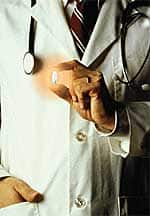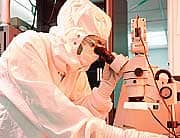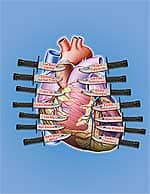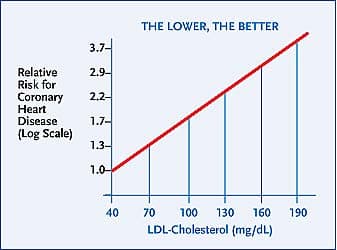Life Extension Magazine®
For the enlightenment of new members, no one has battled the pharmaceutical industry longer and harder than the Life Extension Foundation. Dating back to the early 1980s, we have published exposés on dangerous, ineffective, and outrageously priced prescription drugs. These eye-opening reports enabled us to appear on national broadcasts to get the truth out about how Americans are defrauded by a drug cartel whose political contributions and lobbying efforts buy considerable protection from the federal government. This time, however, I have to defend a class of drugs that have limited efficacy, but are being attacked by the media and some members of Congress in such a misleading way that consumers are calling us asking if they should continue taking them. One Pill Won’t Prevent AtherosclerosisDrug companies mislead the public by proclaiming that taking one pill a day may somehow prevent heart attacks and stroke. This deception carries through to the research divisions of drug companies, who then design clinical studies to see if taking one pill a day really prevents atherosclerosis (the major cause of heart attack and stroke).
The problem is that there are at least 14 independent risk factors that cause arteries to narrow (occlude) as we age. While high LDL (low-density lipoprotein) and total cholesterol are two of these causes, the other 12 atherogenic factors also have to be controlled if aging humans expect to maintain lifelong healthy blood flow. To the left of this page is a graphic of 14 daggers aimed at the heart, each dagger representing an independent risk factor for coronary artery disease. Any one of these daggers can trigger a coronary blockage (heart attack). It is thus absurd to think that just lowering LDL and total cholesterol will provide sufficient protection against atherosclerosis. Statin drugs lower LDL and cholesterol and help mitigate some of these other 12 cardiac risk factors, such as reducing vascular inflammation. Much more is needed, however, to protect against arterial occlusion as we age. Pharmaceutical Companies Shoot Themselves in the FootPeople today want simple solutions. Wouldn’t it be convenient if we could all take the same dose of a statin drug and not worry about coronary or cerebral arterial disease? That’s apparently what two pharmaceutical companies thought when they designed a clinical trial (the ENHANCE trial)1-3 to measure the effectiveness of Vytorin® (the combination of simvastatin and Zetia® [ezetimibe]) versus simva-statin alone against carotid artery thickening, a surrogate measurement of systemic atherosclerosis.
At the conclusion of this Vytorin®-simvastatin study, patients in both treatment groups showed similar, albeit moderate benefits. The additive LDL-lowering effect produced by Vytorin® did not provide any additional benefit over simvastatin alone, leading some to question whether cholesterol is really a risk factor for atherosclerosis. Others implied that statin drugs may not provide the benefits claimed by pharmaceutical companies. Since so many Americans take statin drugs, the media turned these unscientific opinions into headline news stories. Some Congressional Representatives then called for hearings to determine if Americans were being deceived into buying worthless medications. The public was understandably perplexed. Most Life Extension members, however, saw through the tabloid-like media frenzy surrounding the release of a study that did show some clinical benefit relative to historical controls who received no treatment. The absurdity of all of this was that pharmaceutical company greed caused them to design a study that was likely to fail. The economic objective was to show that high-dose Vytorin® (comprising 80 mg of simvastatin and 10 mg of Zetia®) was superior to high-dose simvastatin (80 mg) alone in preventing carotid artery thickening. If the study showed superior results in the Vytorin® group, the makers of Vytorin® could have run national ads proclaiming that their expensive patented combination drug was superior to low-cost generic statins in preventing arterial thickening with age. One flaw in this study, of course, is that the 12 other risk factors (daggers) were not adequately corrected. As you will read, there were other serious flaws that rendered the findings largely meaningless. Don’t Toss Out Statin DrugsNothing in this widely publicized Vytorin®-simvastatin study implied that the drugs were worthless. In fact, both drugs did what they were supposed to, i.e., they lowered LDL and cholesterol. The drugs did not, however, show significant differences between one another in terms of slowing the progression of carotid artery thickening. While worried patients called their cardiologists asking what could now be done to prevent heart attack and stroke, Life Extension members found comfort in knowing that they were controlling all the known risk factors that cause arterial blockage. We long ago recommended that individuals with LDL levels above 100 mg/dL and total cholesterol above 200 mg/dL of blood use the lowest dose of a statin drug to reduce LDL-cholesterol numbers to optimal target levels if natural methods failed. We pointed to studies showing that LDL and total cholesterol can often be brought into optimal ranges by using a low dose of a statin drug with virtually no risk of side effects. For example, some people are prescribed 20-80 mg a day of simvastatin, yet only 5-10 mg a day are all that is needed by many to achieve optimal LDL-cholesterol levels.4,5
The Vytorin®-Simvastatin StudyIn the misunderstood study of Vytorin® and simvastatin, a group of patients were evaluated who had a genetic defect that causes them to produce dangerously high amounts of LDL and cholesterol. This disorder is called heterozygous familial hypercholesterolemia, and it affects only one in 500 people.
One group was given Vytorin® (simvastatin 80 mg and Zetia® 10 mg) while the other half received simvastatin (80 mg) (trademarked name Zocor®) alone over a two-year period. Zetia® inhibits cholesterol absorption, while simvastatin inhibits cholesterol synthesis in the liver. An ultrasound test was used to evaluate the inner wall thickness of the carotid arteries, which is a surrogate marker for the presence of atherosclerosis in the heart, brain, and other parts of the body. When the study results showed no significant slowing of carotid artery thickness in either group, the concept of cholesterol’s involvement in atherosclerosis and the value of cholesterol-lowering drugs were challenged by the media, certain members of Congress, and even some in the FDA. What everyone overlooked, however, is that neither group achieved enough of a reduction of LDL to significantly slow carotid artery blockage. Study subjects started out with a startlingly high average 320 (mg/dL) LDL blood reading. The simvastatin-alone group’s LDL declined to an average of 188, whereas Vytorin® lowered average LDL to 134. At the conclusion of the study, the Vytorin® group showed no greater benefits than the group receiving the lower-cost simvastatin. Although the Vytorin® group showed a larger reduction in LDL, there were no differences in cardiovascular events between the Vytorin® and simvastatin groups in the trial. This led some to question the role of cholesterol in atherosclerosis, while others stated that consumers were being ripped off by purchasing higher-cost Vytorin®. They all got it wrong! LDL and Cholesterol Not Lowered EnoughThese high-risk study patients with a known genetic disorder suffered most of their lives with excess levels of LDL and cholesterol. 18,19 This means that when they entered the study, their endothelium (inner arterial wall) had already suffered significant structural damage. A review of past studies reveals that the target LDL-reduction level needed to protect against progression of atherosclerosis is definitely below 100 (mg/dL) and probably below 76 mg/dL.20-25 Yet the drug doses used in this study only lowered LDL levels to 188 for simvastatin and 134 for Vytorin®.
The media, most lay people, and regrettably, too many doctors think that lowering toxic LDL from 320 (at baseline) to 188 and 134 at the study’s end should have produced significant benefits. The hard facts gleaned from clinical studies involving tens of thousands of aging human beings make it clear that LDL must be reduced to below 70-76 in high-risk patients to produce a meaningful reduction in heart attack risk and surrogate markers of cardiac risk (such as ultrasound testing to measure carotid occlusion).22,25,26 Healthy aging people should strive for LDL levels below 100. Chart 1 on this page provides striking data to document that in order to prevent heart attack in high-risk individuals, LDL needs to be lowered far more than was accomplished in the Vytorin®-simvastatin study. To directly correlate the relationship of achieved LDL level to progression of carotid artery occlusion, all one has to do is look at a study that evaluated the effects of a potent statin drug called Crestor® (rosuvastatin). In the group receiving Crestor®, LDL baseline levels of 155 (mg/dL) were reduced to 78. There was no progression in carotid occlusion in the Crestor® group who achieved this low level (78 mg/dL) of LDL, whereas the placebo group significantly worsened.28 This Crestor® study thus showed that patients with an LDL of 155 suffer rapid progression of carotid occlusion. In the Vytorin®-simvastatin study, LDL was only lowered to 134-188—clearly not low enough to significantly protect against carotid occlusion.
Data supporting the need for normal aging people to keep their LDL levels below 100 (and high- risk patients below 70-76) are not new.4,29,30 Life Extension established the below-100 LDL guideline in the early 1980s, and this is now considered the optimal range by health organizations around the world. Pharmaceutical companies, however, are not particularly interested in scientific solutions to eradicate lethal diseases. The intention of this study was to show Vytorin® is superior to simvastatin—period. The study backfired because other independent risk factors were not treated and because LDL was not sufficiently lowered.
LDL could have been reduced to a safer level if these patients were also prescribed a drug called cholestyramine to block cholesterol reabsorption from the intestines;31-33 a beta-glucan fiber blend that also blocks intestinal cholesterol reabsorption;34-36 and/or moderate-dose niacin that not only lowers LDL, but also reduces small, dense LDL particles that are particularly atherogenic.37-40 The negative findings of this study will cost the makers of Vytorin® a lot of money. Based on the adverse media exposure, many patients are stopping Vytorin® and switching to far less costly generic statin drugs. There is nothing wrong with changing to a lower-cost generic as long as LDL levels of under 100 (and under 70-76 for high-risk groups) are achieved. Remember, it’s not the brand of drug that matters. What counts is the achieved reduction in LDL. Why Can’t Everyone Suppress LDL to the Lowest Range?Despite an abundance of human clinical data, most doctors ignore LDL levels that are too high (over 100 mg/dL of blood).4 Chart 2 below shows the consensus that now exists between the American Heart Association, the National Institutes of Health, and the National Cholesterol Education Program on what optimal LDL levels should be. When reviewing Chart 1 on page 10, however, you might wonder why every aging person does not strive for LDL levels below 70. After all, these lower levels clearly reduce heart attack risk. One problem is that the high doses of statin drugs needed to lower LDL below 70 are toxic to many people. The other problem is that drugs that reduce LDL also lower cholesterol levels. While too much cholesterol is an atherogenic risk factor, population-based studies suggest that too little cholesterol is associated with an increase in mortality and morbidity.41 For these reasons, Life Extension believes that for optimal risk/ benefit, the ideal range for total cholesterol is between 180 and 200 mg/dL. Studies suggest that total cholesterol levels below 180 mg/dL increase the risk of suicidal behavior,42,43 hemorrhagic stroke,44 depression,45 and cancer.46 For certain high-risk patient groups, sharply lowering LDL for a three to- six-month time period is desirable.47 This group includes those who have undergone coronary artery bypass surgery or who have had a stent inserted to open up an occluded coronary artery. These patients undergo an inflammatory storm after these surgical procedures that make them vulnerable to another heart attack. These patient groups are often put on a three to- six-month regimen of a high-dose statin drug to achieve LDL levels below 70.
Natural Methods Reverse Carotid Artery OcclusionWhile the media was caught up bashing statin drugs, no one mentioned that there are non-drug approaches that have been documented to reverse clinical measurements of systemic atherosclerosis. Scientific studies have demonstrated the ability of pomegranate and a natural superoxide dismutase (SOD)-enhancing agent trademarked GliSODin® to reverse carotid ultrasound markers of atherosclerosis better than any prescription drug.51-54 While some drugs, nutrients, and hormones can slow the progression of atherosclerosis, very little has ever been shown to reverse existing artery disease. One reason it is so difficult to reverse atherosclerosis is that arterial disease is primarily caused by aging itself (via the destructive process known as endothelial dysfunction). What this means is that a person with atherosclerosis has to first stop the artery-damaging process and then reverse the damage to the arterial wall that has accumulated over a lifetime. Atherosclerosis can be measured in humans by conducting an ultrasound test of their carotid arteries in the neck. An ultrasound provides a specific reading of the narrowing (or blockage) that has occurred by measuring the thickness of the inner and middle walls of the carotid artery. This is known technically as an intima-media thickness test (IMT). A controlled human study was conducted involving patients with severe carotid artery narrowing (stenosis). One group received conventional drugs only (statins and antihypertensives), while the other group received pomegranate juice plus the same drugs. The findings observed in the pomegranate group were unprecedented.54
After one year, the group receiving the drugs, but not pomegranate showed a significant 9% increase in intima-media thickness. In contrast, the group receiving the pomegranate plus drugs showed a reduction in carotid intima-media thickness as follows: After three months: 13% After six months: 22% After nine months: 26% After one year: 35% Carotid artery blood flow (as measured by end diastolic velocity) improved in the pomegranate plus drugs group as follows: After three months: 16% After six months: 20% After nine months: 31% After one year: 44% Throughout the study period, the scientists sought to determine why pomegranate so effectively reversed these documented parameters of atherosclerosis. Blood samples were collected before and during treatment with pomegranate. The following changes were discovered in the pomegranate group: Another blood test used in this study was to measure an antioxidant enzyme called paraoxonase-1 that is naturally produced in the body. Paraoxonase-1 is believed to protect against the oxidation of LDL. Low levels of paraoxonase-1 predict increased severity of coronary artery disease. In patients administered pomegranate, the paraoxonase-1 levels increased by 83% after only one year!54 The scientists attributed the regression in carotid atherosclerotic lesion size in the pomegranate group to significantly reduced oxidative stress in both blood and atherosclerotic plaques, along with modestly lower blood pressure (beyond that of the antihypertensive drugs that were prescribed). When looking at these incredible improvements in arterial health, the mere “slowing of worsening progression” that statin drugs are able to accomplish looks quite pathetic in comparison. Despite the research substantiating the value of these natural approaches, Life Extension remains adamant in its recommendation that members make sure that all vascular risk factors (the 14 daggers) be kept in optimal ranges. Vascular diseases are by far the leading killers of aging humans.55 If we are to maintain healthy blood flow over the long lives we strive for, then we must guard against the many factors that conspire to starve our tissues of oxygenated blood. Medical Decisions Should Be Based on YOUR Blood Results—Not Media Hype!In response to the Vytorin®-simvastatin study, and subsequent misinterpretation and hype by the media, aging humans who could benefit from individualized LDL-lowering therapies are questioning what they should be doing. We at Life Extension seem to be the only ones who have analyzed this study and found that it proves what was learned decades ago, i.e., LDL levels above 100 mg/dL of blood contribute to the worsening of atherosclerosis. The only way to be confident that you are in the lowest risk category for suffering a stroke or heart attack is to have your blood comprehensively tested annually. For the past twelve years, Life Extension members have had open access to low-cost blood testing. As greater volumes of these comprehensive blood tests have been ordered, the cost to perform them has gone down. To order the comprehensive Male or Female Blood Test Panels or any other tests at extra-discounted prices, call 1-800-208-3444. For longer life,
William Faloon
| ||||||||||||||||||||||||||||||||||||||||||||||||||||||||||||||
| References | ||||||||||||||||||||||||||||||||||||||||||||||||||||||||||||||
| 1. Available at: http://www.medscape.com/viewarticle/568763. Accessed February 21, 2008. 2. Available at: http://cnnmoney.mobi/money/archive/archive/detail/30000/full;jsessionid=E60199B5E4B6E60179A16775B0CBE1ED. Accessed February 21, 2008. 3. Available at: http://www.fda.gov/cder/drug/early_comm/ezetimibe_simvastatin.htm. Accessed February 21, 2008. 4. Ichimaru N, Takahara S, Kokado Y, et al. Changes in lipid metabolism and effect of simvastatin in renal transplant recipients induced by cyclosporine or tacrolimus. Atherosclerosis. 2001 Oct;158(2):417-23. 5. Schnee DM, Bogdanski L, Zaiken K, McCloskey WW. An evaluation of low-dose simvastatin in achieving LDL goal: a retrospective chart review. Manag Care Interface. 2007 May;20(5):53-7. 6. Jeong YJ, Choi YJ, Kwon HM et al. Differential inhibition of oxidized LDL-induced apoptosis in human endothelial cells treated with different flavonoids. Br J Nutr. 2005 May;93(5):581-91. 7. Aviram M, Fuhrman B. Wine flavonoids protect against LDL oxidation and atherosclerosis. Ann NY Acad Sci. 2002 May;957:146-61. 8. Fuhrman B, Volkova N, Rosenblat M, Aviram M. Lycopene synergistically inhibits LDL oxidation in combination with vitamin E, glabridin, rosmarinic acid, carnosic acid, or garlic. Antioxid Redox Signal. 2000;2(3):491-506. 9. Siow RC, Richards JP, Pedley KC, Leake DS, Mann GE. Vitamin C protects human vascular smooth muscle cells against apoptosis induced by moderately oxidized LDL containing high levels of lipid hydroperoxides. Arterioscler Thromb Vasc Biol. 1999 Oct;19(10):2387-94. 10. Regnstrom J, Nilsson J, Moldeus P, et al. Inverse relation between the concentration of low-density-lipoprotein vitamin E and severity of coronary artery disease. Am J Clin Nutr. 1996 Mar;63(3):377-85. 11. Offermann MK, Medford RM. Antioxidants and atherosclerosis: a molecular perspective. Heart Dis Stroke. 1994 Jan;3(1):52-7. 12. Sezer ED, Akçay YD, Ilanbey B, Yildirim HK, Sözmen EY. Pomegranate wine has greater protection capacity than red wine on low-density lipoprotein oxidation. J Med Food. 2007 Jun;10(2):371-4. 13. Wilkins GM, Leake DS. The oxidation of low density lipoprotein by cells or iron is inhibited by zinc. FEBS Lett. 1994 Mar 21;341(2-3):259-62. 14. Manson JE, Gaziano JM, Jonas MA, Hennekens CH. Antioxidants and cardiovascular disease: a review. J Am Coll Nutr. 1993 Aug;12(4):426-32. 15. Superko HR, Nejedly M, Garrett B. Small LDL and its clinical importance as a new CAD risk factor: a female case study. Prog Cardiovasc Nurs. 2002;17(4):167-73. 16. Cromwell WC, Otvos JD. Low-density lipoprotein particle number and risk for cardiovascular disease. Curr Atheroscler Rep. 2004 Sep;6(5):381-7. 17. St-Pierre AC, Ruel IL, Cantin B, et al. Comparison of various electrophoretic characteristics of LDL particles and their relationship to the risk of ischemic heart disease. Circulation. 2001 Nov 6;104(19):2295-9. 18. Ferrieres J, Lambert J, Lussier-Cacan S, Davignon J. Coronary artery disease in heterozygous familial hypercholesterolemia patients with the same LDL receptor gene mutation. Circulation. 1995 Aug 1;92(3):290-5. 19. Available at: http://www.cdc.gov/genomics/hugenet/reviews/FHCauses.htm. Accessed February 22, 2008. 20. Rouleau J. Improved outcome after acute coronary syndromes with an intensive versus standard lipid-lowering regimen: results from the Pravastatin or Atorvastatin Evaluation and Infection Therapy-Thrombolysis in Myocardial Infarction 22 (PROVE IT-TIMI 22) trial. Am J Med. 2005 Dec;118 Suppl 12A:28-35. 21. Scheen AJ, Kulbertus H. Clinical study of the month. REVERAL and PROVE-IT: confirmation of the concept “the lower, the better” for cholesterol therapy in patients with coronary heart disease. Rev Med Liege. 2004 Mar;59(3):167-73. 22. Grundy SM, Cleeman JI, Merz CN, et al. Implications of recent clinical trials for the National Cholesterol Education Program Adult Treatment Panel III guidelines. Circulation. 2004 Jul 13;110(2):227-39. 23. Cannon CP, Braunwald E, McCabe CH, et al. Comparison of intensive and moderate lipid lowering with statins after acute coronary syndromes. N Engl J Med. 2004 350:1495-504. 24. Jacobson TA. The safety of aggressive statin therapy: how much can low-density lipoprotein cholesterol be lowered? Mayo Clin Proc. 2006 Sep;81(9):1225-31. 25. Nissen SE, Nicholls SJ, Sipahi I, et al. Effect of very high-intensity statin therapy on regression of coronary atherosclerosis: the ASTEROID trial. JAMA. 2006 Apr 5;295(13):1556-65. 26. O’Keefe JH, Jr., Cordain L, Harris WH, Moe RM, Vogel R. Optimal low-density lipoprotein is 50 to 70 mg/dl: lower is better and physiologically normal. J Am Coll Cardiol. 2004 Jun 2;43(11):2142-6. 27. Ridker PM, Cannon CP, Morrow D, et al. C-reactive protein levels and outcomes after statin therapy. N Engl J Med. 2005 Jan 6;352(1):20-8. 28. Crouse JR, III, Raichlen JS, Riley WA, et al. Effect of rosuvastatin on progression of carotid intima-media thickness in low-risk individuals with subclinical atherosclerosis: the METEOR Trial. JAMA. 2007 Mar 28;297(12):1344-53. 29. Available at: http://www.nhlbi.nih.gov/guidelines/cholesterol/upd-info_prof.htm. Accessed February 24, 2008. 30. Available at: http://www.nih.gov/news/pr/jul2004/nhlbi-12.htm. Accessed February 24, 2008. 31. Available at: http://www.medicinenet.com/cholestyramine/article.htm. Accessed February 25, 2008. 32. Garg A, Grundy SM. Cholestyramine therapy for dyslipidemia in non-insulin-dependent diabetes mellitus. A short-term, double-blind, crossover trial. Ann Intern Med. 1994 Sep 15;121(6):416-22. 33. McNamara DJ, Davidson NO, Samuel P, Ahrens EH, Jr. Cholesterol absorption in man: effect of administration of clofibrate and/or cholestyramine. J Lipid Res. 1980 Nov;21(8):1058-64. 34. Queenan KM, Stewart ML, Smith KN, et al. Concentrated oat beta-glucan, a fermentable fiber, lowers serum cholesterol in hypercholesterolemic adults in a randomized controlled trial. Nutr J. 2007;66. 35. Keenan JM, Goulson M, Shamliyan T, et al. The effects of concentrated barley beta-glucan on blood lipids in a population of hypercholesterolaemic men and women. Br J Nutr. 2007 Jun;97(6):1162-8. 36. Braaten JT, Wood PJ, Scott FW, et al. Oat beta-glucan reduces blood cholesterol concentration in hyper-cholesterolemic subjects. Eur J Clin Nutr. 1994 Jul;48(7):465-74. 37. Brown BG, Zhao XQ, Chait A, et al. Simvastatin and niacin, antioxidant vitamins, or the combination for the prevention of coronary disease. N Engl J Med. 2001 Nov 29;345(22):1583-92. 38. Capuzzi DM, Guyton JR, Morgan JM, et al. Efficacy and safety of an extended-release niacin (Niaspan): a long-term study. Am J Cardiol. 1998 Dec 17;82(12A):74U-81U. 39. Canner PL, Berge KG, Wenger NK, et al. Fifteen year mortality in Coronary Drug Project patients: long-term benefit with niacin. J Am Coll Cardiol. 1986 Dec;8(6):1245-55. 40. Berra K. Clinical update on the use of niacin for the treatment of dyslipidemia. J Am Acad Nurse Pract. 2004 Dec;16(12):526-34. 41. Schatz IJ, Masaki K, Yano K, et al. Cholesterol and all-cause mortality in elderly people from the Honolulu Heart Program: a cohort study. Lancet. 2001 Aug 4;358(9279):351-5. 42. Kim YK, Myint AM. Clinical application of low serum cholesterol as an indicator for suicide risk in major depression. J Affect Disord. 2004 Aug;81(2):161-6. 43. Favaro A, Caregaro L, Di PL, Brambilla F, Santonastaso P. Total serum cholesterol and suicidality in anorexia nervosa. Psychosom Med. 2004 Jul;66(4):548-52. 44. Goldstein LB, Amarenco P, Szarek M, et al. Hemorrhagic stroke in the Stroke Prevention by Aggressive Reduction in Cholesterol Levels study. Neurology. 2007 Dec 12 [Epub ahead of print] 45. Suarez EC. Relations of trait depression and anxiety to low lipid and lipoprotein concentrations in healthy young adult women. Psychosom Med. 1999 May;61(3):273-9. 46. Shor R, Wainstein J, Oz D, et al. Low serum LDL cholesterol levels and the risk of fever, sepsis, and malignancy. Ann Clin Lab Sci. 2007 Autumn;37(4):343-8. 47. Miller M. Optimal treatment of dyslipidemia in high-risk patients: intensive statin treatment or combination therapy? Prev Cardiol. 2007;10(1):31-5. 48. Available at: http://www.nhlbi.nih.gov/health/public/heart/chol/wyntk.htm. Accessed March 4, 2008. 49. Available at: http://www.nlm.nih.gov/medlineplus/ency/article/003495.htm. Accessed March 4, 2008. 50. Available at: http://www.americanheart.org/presenter.jhtml?identifier=183. Accessed March 4, 2008. 51. Cloarec M, Caillard P, Provost JC, et al. GliSODin, a vegetal sod with gliadin, as preventative agent vs. atherosclerosis, as confirmed with carotid ultrasound-B imaging. Eur Ann Allergy Clin Immunol. 2007 Feb;39(2):45-50. 52. de NF, Williams-Ignarro S, Sica V, et al. Effects of a pomegranate fruit extract rich in punicalagin on oxidation-sensitive genes and eNOS activity at sites of perturbed shear stress and atherogenesis. Cardiovasc Res. 2007 Jan 15;73(2):414-23. 53. Kaplan M, Hayek T, Raz A, et al. Pomegranate juice supplementation to atherosclerotic mice reduces macrophage lipid peroxidation, cellular cholesterol accumulation and development of atherosclerosis. J Nutr. 2001 Aug;131(8):2082-9. 54. Aviram M, Rosenblat M, Gaitini D, et al. Pomegranate juice consumption for 3 years by patients with carotid artery stenosis reduces common carotid intima-media thickness, blood pressure and LDL oxidation. Clin Nutr. 2004 Jun;23(3):423-33. 55. Available at: http://www.medicinenet.com/script/main/art.asp?articlekey=62218. Accessed March 4, 2008. | ||||||||||||||||||||||||||||||||||||||||||||||||||||||||||||||







